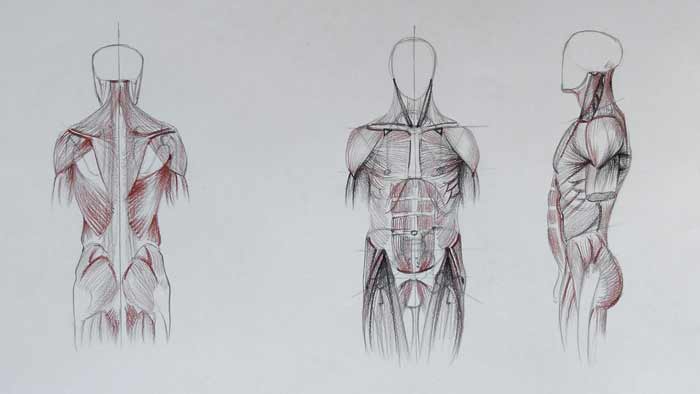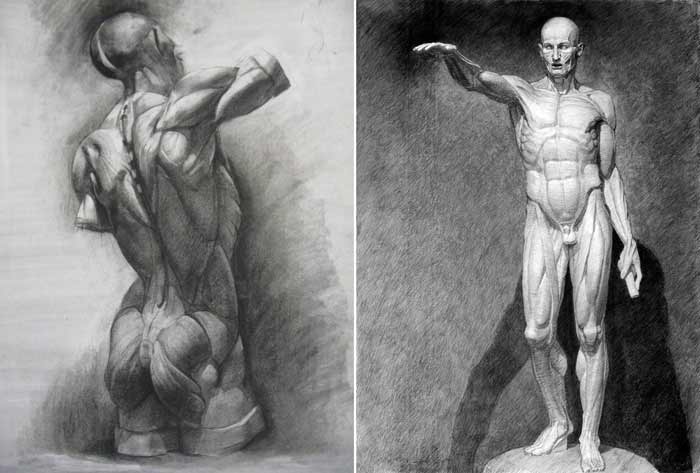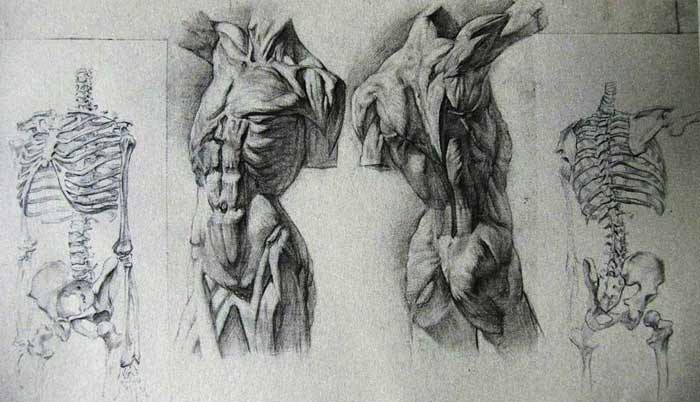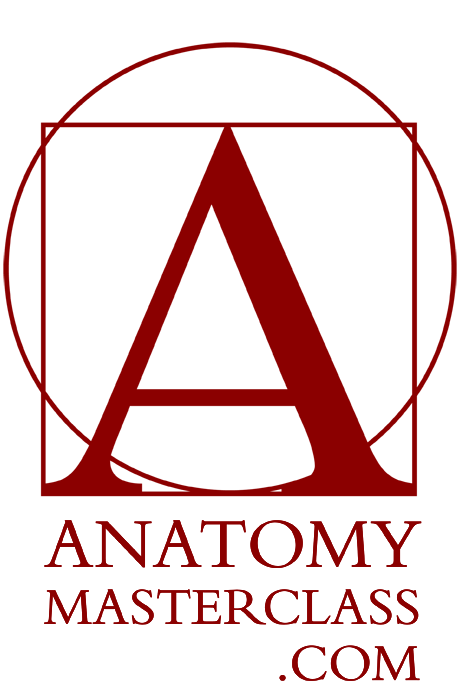Muscles of the Body
Muscles of the Body
Anatomy Lesson 7 – Part 2
In this video lesson, you will discover the muscles of the body.
Muscles of the body – rear view
When talking about muscles of the body, let’s start in no particular order from the muscle of the back, which is called the latissimus dorsi. It covers most of the back. This muscle has a triangular shape and starts from the lower six vertebrae of the ribcage (also from the vertebrae of the waist, or lumbar region) and from the inner crest of the pelvis (as well as from the lower three ribs) and inserts into the humerus, which is the upper arm bone. It is responsible for extension of the arms (bringing the arm down from a lifted position) as well as for medial rotation (rotating the arm inward).



Another important muscle of muscles of the body on the rear side of the torso is the back muscle. It travels from the pelvis and up to the cervical region of the spine. This muscle covers the whole length of the back. The main function of this muscle is to keep the body upright. This muscle consists of several smaller muscles. However, for a fine artist, it is not necessary to examine deep into its anatomy.
The deltoid is another muscle that every figurative artist must know. Its back portion begins from the spine of the shoulder blade and inserts into the middle of the humerus, or upper arm bone. The deltoid lifts the arm and rotates the arm outward.
Trapezium muscle also contributes to the body appearance. The middle portion of the trapezium begins from the neck, or cervical region, of the spinal column and also stretches from the first three vertebrae of the ribcage column. It inserts into the acromion, which is a part of the shoulder blade, and also inserts into the spine of the shoulder blade. The third, or lower, portion of the trapezium muscle begins from the fourth vertebra and ends at the twelfth vertebra of the ribcage spine and inserts into the spine of the shoulder blade. The main action of the trapezium muscle is to move the shoulder blades. Each of the three portions of the trapezium muscle contributes to different shoulder blade movements. The upper portion lifts the shoulders upward and rotates the shoulder blades outward. When the middle portion of the trapezium muscle contracts, it brings the shoulder blades closer together. When the lower portion of the trapezium muscle is in action, it pulls the shoulders backward and downward.
The external oblique muscle mostly covers the torso in the front and sides. On the back side, it is connected to the iliac crest of the pelvis.
The buttocks muscles consist of several muscles which, in Latin, are called the gluteal group. The biggest muscle of this group is the gluteus maximus. This buttocks muscle is the most powerful in the group. The main action of this muscle is to move the thigh backward and assist in rotating the upper leg outward. It engages in movements such as going uphill or upstairs. This muscle starts from the back portion of the iliac crest of the pelvis and sacrum and inserts into the upper side of the femur (an upper bone of the leg).
Another muscle of the buttocks group is the gluteus medius. It starts from the upper portion of the ilium of the pelvis and inserts into the upper edge of the femur, which is the thighbone. The main function of this muscle is to move the upper leg outward and away from the body.
Muscles of the body – front view
At the top, there is the front portion of the deltoid muscle. This portion of the deltoid connects to the outer half of the collarbone and inserts into the middle of the humerus bone, which is the bone of the upper arm. This portion of the deltoid raises the upper arm in an upward direction and also raises it in front of the body.
In front of the chest, there is one large and powerful muscle called the pectoralis major. This is the chest muscle, which covers most of the chest. It consists of three portions: the upper, middle, and lower portions. The upper portion is called the clavicular portion. The middle portion of the breastbone is called the sternal portion and the lower portion is called the abdominal portion. The clavicular portion of this muscle begins from the inner part of the collarbone. The sternal portion begins from the breastbone and the abdominal portion starts from the sixth and the seventh pair of ribs. This muscle inserts into the humerus – the upper arm bone. The place of insertion in the upper arm is covered by the deltoid muscle.
This muscle contributes to many movements of the upper arm. It rotates the arm inward, raises the arm in front of the body, and also brings the arm toward the body in front of the torso. It is used in motions such as the butterfly stroke in swimming.
The neck muscle begins from the pit of the neck and travels upward. It inserts into the base of the skull just behind the ear. This muscle forms the front part of the neck. The back part of the neck is formed by the trapezius and other neck muscles.
The abdominal part of the torso is covered by a long and powerful muscle called the rectus abdominis, otherwise known as the six-pack. This abdominal muscle inserts into the fifth, sixth, and seventh costal cartilage of the ribcage. The abdominal muscle consists of two powerful portions which are separated by the vertical white line in the middle. These portions are also subdivided into separate packs, hence the name six-pack. This muscle originates from the pubic bone of the pelvis. The main action of the abdominal muscle is to bend the body forward.
The external oblique muscle covers the sides of the torso. The flank pad portion is found in the lower region. Stretching and compressing the flank pads result in flexion and rotation of the body.
The middle buttocks muscle is located between the iliac crest of the pelvis and the upper edge of the thighbone. This muscle helps lift the leg sideways.
From the front edge of the pelvis crest, we can follow the tailor’s muscle, or the sartorius muscle. It inserts inside the lower leg next to the knee and helps bring the lower leg upward in a cross-legged position. It is called the tailor’s muscle because tailors are known to frequently sit cross-legged.
Muscles of the body – side view
The abdominal part of the torso is covered by the abdominal muscle. It begins from the pubic bone of the pelvis and travels upward to the ribcage…
[ The full lesson is avaibale to Anatomy Master Class members ]
To find out more about muscles of the body, enroll in the Anatomy Master Class
Simple Pricing, No Surprises
One-time payment - Only $97 USD
ENROLL NOW



